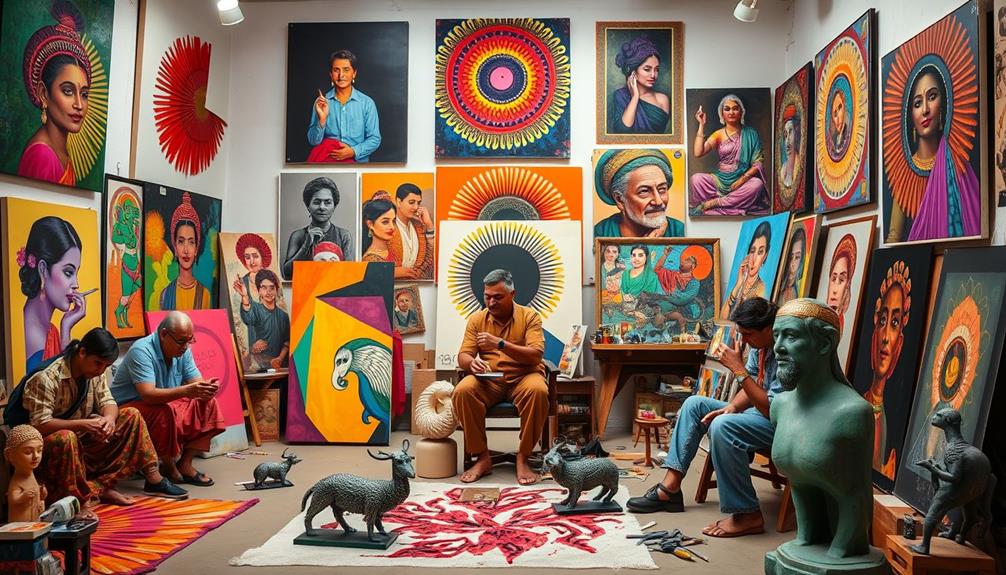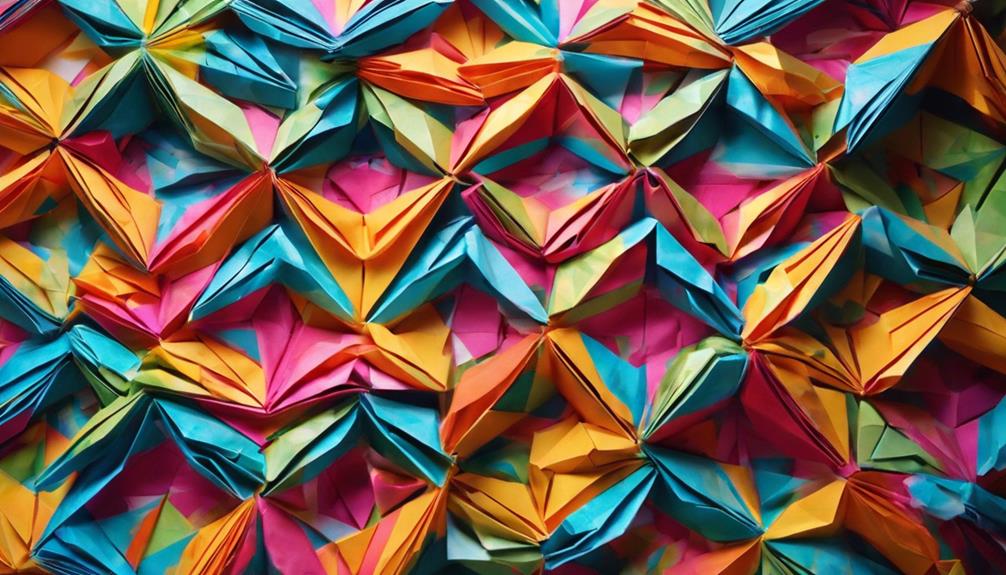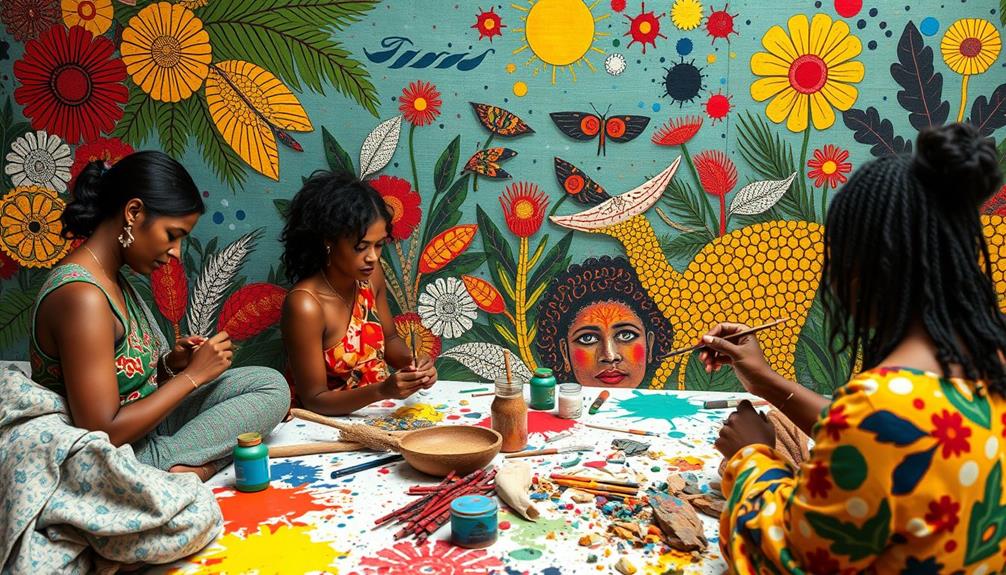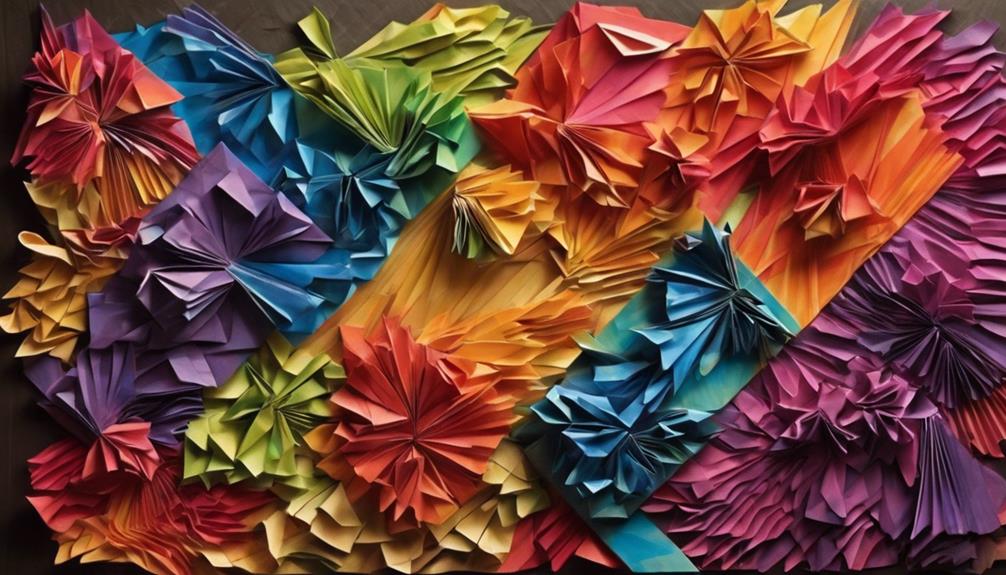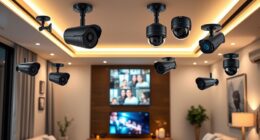Gaganendranath Tagore's satirical works offer a nuanced exploration of colonial India's societal norms and power dynamics in the early 20th century. His pieces analyze the complexities of that era, presenting a thought-provoking perspective for understanding the cultural and social landscape of the time. Through his art, Tagore explores the intricacies of Bengali society, critiquing the anglicized elite, gender roles, and the impact of British colonialism. His unique blend of humor and incisive commentary challenges traditional beliefs, inviting viewers to reflect on the multi-layered dynamics of colonial India. Further insights into his works reveal a deeper understanding of the societal structures he depicted.
Key Takeaways
- Gaganendranath Tagore's satire critiques colonial class dynamics in Bengal.
- Tagore cleverly exposes societal impacts of British colonialism in India.
- His works challenge gender roles, societal norms, and anglicized Bengali elite.
- Tagore's satire reflects tensions between tradition and modernity in colonial India.
- His art offers profound commentary on social and cultural complexities of early 20th-century India.
Early Life and Influences
Born into the influential Tagore family in 1867, Gaganendranath Tagore's early life was shaped by the artistic legacies of his uncle Rabindranath Tagore and brother Abanindranath Tagore. Growing up amidst the vibrant cultural milieu of Bengal, Gaganendranath was exposed to the rich artistic traditions of the Bengal School of Art, which his family played a significant role in shaping. Influenced by both European and Oriental art forms, he developed a unique style that blended traditional techniques with modern sensibilities.
His uncle Rabindranath Tagore, a renowned poet and Nobel laureate, and his brother Abanindranath Tagore, a prominent artist and key figure in the Bengal School of Art, provided Gaganendranath with invaluable guidance and inspiration. These early influences laid the foundation for his later explorations into satire and social commentary through art.
Gaganendranath's upbringing within such a culturally and artistically rich environment greatly influenced his artistic sensibilities and set the stage for his groundbreaking satirical works that challenged societal norms and conventions.
Exploration of Colonial Society

Gaganendranath Tagore's satirical works offer a critical lens into the colonial class dynamics prevalent in early 20th century India. Through his art, Tagore skillfully depicted and satirized the societal norms imposed by British colonial rule, shedding light on power structures that perpetuated inequality.
His cartoons serve as a poignant critique of the hypocrisy and contradictions deeply embedded within colonial Indian society.
Colonial Class Dynamics
In his satirical works, Gaganendranath Tagore explored the complexities of colonial class dynamics in early twentieth-century India, providing a critical lens on the struggles and aspirations of the Bengali society under British rule.
Tagore's caricatures vividly depicted the challenges faced by the middle and upper-class Bengalis under colonial India's influence. Through his art, Tagore offered a sharp commentary on the anglicized Bengali elite and their interactions with the British colonial powers.
By employing humor and wit in his sketches, Tagore effectively highlighted the tensions and contradictions prevalent within the colonial society, particularly concerning social hierarchy and cultural assimilation.
His satirical approach not only entertained but also served as a powerful tool to shed light on the intricate nuances of colonial class dynamics and societal norms prevalent during that era.
Tagore's works continue to be a valuable resource for understanding the colonial history of India and the multifaceted dynamics of the society under British rule.
Satirical Societal Norms
Exploring the intricate web of colonial society, Tagore's satirical works cut through societal norms with incisive humor and critique. The Indian Society of Oriental Art served as a platform for Tagore to challenge prevalent societal norms through his art.
Key points to note include:
- Critique of British colonial impact: Tagore's satirical works exposed the cultural and societal repercussions of British colonialism on India, shedding light on the complexities of cultural synthesis.
- Challenge to anglicized aspirations: Through his art, Tagore satirized the adoption of Western ideals and anglicized aspirations within Indian society, questioning the authenticity of such pursuits.
- Examination of caste oppression: Tagore's satirical commentary explored the oppressive caste system, highlighting the injustices and inequalities perpetuated within Indian society. His provocative art aimed to spark reflection and dialogue on these deeply ingrained societal norms.
Power Structures Critique
Tagore's satirical works on power structures within colonial society revealed the underlying dynamics of authority and influence in a time of significant societal upheaval. Through his satirical caricatures, Tagore critiqued the established power structures, particularly focusing on the Brahminical hierarchy. His cartoons effectively exposed the hypocrisy and contradictions inherent in the system under British colonial rule.
Tagore's art captured the impact of colonialism on Indian societal structures, shedding light on the anglicized aspirations and norms prevalent during that era. By depicting the struggles faced by middle and upper-class Bengalis, Tagore's satirical commentary provided a poignant reflection of the challenges posed by colonial influence. His works challenged the existing power dynamics, offering a critical perspective on the societal structures that governed the lives of individuals in colonial India.
Tagore's insightful portrayals through satire continue to serve as a thought-provoking exploration of the power dynamics prevalent in colonial society.
Caricatures of Bengali Women

Gaganendranath Tagore's satirical caricatures of Bengali women cleverly depict the complexities of traditional gender roles in colonial India. His cartoons often portrayed Bengali women in traditional roles but with a satirical twist, shedding light on the contradictions and hypocrisies faced by middle and upper-class women during that era.
Through his art, Tagore highlighted the struggles of Bengali women in navigating societal expectations and modern influences. His keen observation of gender dynamics and societal norms is evident in the way he critiqued the constraints imposed on Bengali women by both traditional norms and colonial influences.
- Tagore's caricatures showcase Bengali women in traditional roles with a satirical twist.
- The cartoons highlight the contradictions and hypocrisies faced by middle and upper-class Bengali women.
- Through his art, Tagore critiques the constraints imposed on Bengali women by traditional norms and colonial influences.
Portrayal of Anglicized Bengali Men

In his satirical works, Gaganendranath Tagore cleverly depicted anglicized Bengali men adopting Western mannerisms and clothing, highlighting the conflict between traditional Indian values and the aspirations of the anglicized elite.
Through his cartoons, Tagore humorously critiqued the pretentiousness and mimicry of British culture by these individuals. The anglicized Bengali men in Tagore's art symbolized the struggle faced by the elite class in reconciling their traditional roots with the allure of Westernization during colonial times.
By portraying these characters, Tagore shed light on the cultural identity crisis experienced by many anglicized Bengali men as they sought to navigate the changing societal norms influenced by colonial presence. His satirical approach not only entertained but also served as a poignant commentary on the impact of British colonialism on Indian society and the complexities of cultural assimilation.
Tagore's caricatures effectively captured the nuances of this internal conflict within the anglicized elite, reflecting the broader tensions between tradition and modernity in colonial India.
Social and Cultural Commentary

Gaganendranath Tagore's satirical works serve as a mirror reflecting the societal norms and values of his time.
Through his art, Tagore boldly critiques the prevailing norms, shedding light on the hypocrisy and absurdities within Indian society.
His unique blend of humor and criticism challenges the status quo, offering a profound commentary on the social and cultural landscape of colonial India.
Satire as Mirror
Tagore's satirical works serve as a reflective lens, illuminating the social and cultural intricacies of early 20th-century colonial India. His satirical art, showcased through the Indian Society of Oriental Art, offers a poignant commentary on various aspects of Indian society during that era.
- His cartoons and caricatures provide biting commentary on the hypocrisies, double standards, and societal norms of Bengali society at the time.
- Tagore's satirical art explores themes such as the caste system, anglicized aspirations, and the role of women in Bengali society.
- Through his satirical works, Tagore challenges the status quo and invites viewers to critically analyze the norms and values of his time.
Critique of Norms
Critiquing societal norms with sharp wit and incisive artistry, Gaganendranath Tagore's satirical works cut through the veneer of colonial India's social and cultural fabric. Through his art featured in publications like the 'Modern Review', Tagore fearlessly tackled issues such as religious orthodoxy, Brahminical hierarchy, and the contradictions inherent in Bengali babu culture.
His cartoons, particularly 'Purification By Cow Dung' and 'Nuisance Of A Wife', served as powerful tools for conveying deep social commentary and challenging traditional beliefs. Tagore's satirical approach reflected the colonial influences of his time while also pushing boundaries and questioning established norms.
In the world of Indian art, Tagore's legacy as a satirical artist continues to provoke thought and challenge hypocrisy in contemporary society. By using satire and caricature to critique societal norms, he opened up conversations about the complexities of cultural practices and social hierarchies, leaving a lasting impact on the art world and beyond.
Humor and Criticism
Using humor as a powerful tool, Gaganendranath Tagore's satirical works cleverly dissect societal and cultural norms with sharp criticism. Through his caricatures, Tagore challenges traditional beliefs and practices, prompting viewers to rethink their perspectives.
His cartoons often target the hypocrisy of the Bengali elite and the impact of colonial influences on Indian society. Tagore's satirical art serves as a mirror to reflect on societal issues like caste oppression and gender roles. The wit and satire in Tagore's works invite viewers to engage in critical thinking about the complexities of Indian society.
In the domain of modern art, Tagore's ability to blend humor with incisive commentary showcases his talent for using satire as a vehicle for social and cultural critique. With a keen eye for detail and a knack for exposing societal contradictions, Tagore's satirical pieces continue to provoke thought and spark conversations about the prevailing norms of his time.
Impact on Contemporary Art

Influencing contemporary artists, Gaganendranath Tagore's satirical works challenge societal norms with powerful reflections and critiques in modern art. Tagore's impact on contemporary art, especially within the Indian art scene, is profound.
His cartoons and paintings serve as a significant tool for prompting viewers to contemplate deep-rooted societal issues and hypocrisies that persist in today's world. Contemporary artists draw inspiration from Tagore's bold satirical commentary on cultural and social constructs, utilizing his techniques to address contemporary challenges in their own work.
The enduring relevance of Tagore's satirical works in contemporary art underscores the continued admiration for his artistic vision. By infusing his art with thought-provoking satire, Gaganendranath Tagore has left a lasting legacy that continues to shape and influence the trajectory of modern Indian art.
Legacy in Indian Art Scene

Gaganendranath Tagore's legacy in the Indian art scene continues to resonate today through his lasting artistic influence. His satirical works offer a unique lens through which to analyze cultural impacts and societal norms in early 20th-century India.
Tagore's relevance in modernity lies in his ability to critique and reflect the evolving Indian identity amidst colonial pressures, showcasing the enduring power of satire in contemporary art.
Artistic Influence Today
Tagore's satirical works continue to explore and inspire contemporary Indian artists in their investigation of societal norms and cultural commentary. His legacy in the Indian art scene is characterized by a unique fusion of traditional Indian art forms with modern influences, creating a distinct style that resonates with audiences.
The use of satire and caricature in Tagore's work remains relevant today, providing a lens through which artists critique social issues and cultural contradictions. Artists drawing inspiration from Tagore often delve into themes of identity, colonialism, and societal hypocrisy, reflecting his bold and thought-provoking approach.
Tagore's satirical cartoons, known for their incisive commentary on Indian society, serve as a powerful tool for sparking critical thinking and reflection. By continuing to draw from Tagore's legacy, contemporary Indian artists maintain a strong connection to their cultural roots while pushing boundaries and challenging conventions in the ever-evolving art scene.
Cultural Impact Analysis
Gaganendranath Tagore's satirical works, challenging societal norms in colonial India, continue to leave a lasting imprint on the Indian art scene, emphasizing the significance of critiquing and defying entrenched cultural conventions through artistic expression.
Tagore's exploration goes deep into issues such as anglicized aspirations, gender roles, and caste oppression, shedding light on the cultural complexities of early twentieth-century Indian society.
His legacy in the Indian art scene serves as a reminder of the power art holds in reflecting on cultural synthesis and societal struggles. By portraying the nuances of Bengali life under colonial influences, Tagore's satirical commentary offers a unique perspective on the cultural impact of British rule on Indian society.
Through his thought-provoking works, Tagore continues to inspire contemporary Indian artists to challenge the status quo, inviting them to use art as a tool for social critique and change within the Indian cultural landscape.
Relevance in Modernity
In the modern Indian art scene, the enduring legacy of Gaganendranath Tagore's satirical works continues to captivate contemporary audiences. Tagore's insightful commentary on societal norms and hypocrisies challenges present-day artists to reflect on the intricate cultural complexities of India.
Through his artistry, Tagore provides a critical lens for modern audiences to analyze and comprehend prevalent societal issues, fostering a deeper understanding of the evolving dynamics within Indian society.
Tagore's fusion of European techniques and Indian themes remains influential in shaping the Indian art landscape. His satirical cartoons provoke thought and discussions on the contemporary societal shifts, making his art highly relevant in the modern context.
The enduring relevance of Tagore's works highlights the importance of incorporating historical perspectives into the evolving narrative of the Indian art scene.
Relevance in Modern Society

The satirical works of Gaganendranath Tagore continue to spark critical reflection and dialogue in today's society. Tagore's 'Reform Screams' series, in particular, sheds light on societal deformities and hypocrisies that still resonate in modern times.
His art challenges prevailing societal norms, offering a unique perspective on contemporary issues that provoke thought and introspection. Tagore's deep understanding of Indian culture and society further enhances the relevance of his satirical commentary in today's world.
Symbolism and Satire

Tagore's satirical cartoons employ symbolism to vividly depict and critique societal issues, offering a sharp lens through which to examine prevalent norms and contradictions.
His use of satire and caricature in his art serves as a powerful tool to challenge societal structures and beliefs.
Through his cartoons, Tagore masterfully critiques various aspects of society, such as caste oppression, hypocrisy, Bengali babu culture, and religious orthodoxy.
- Tagore's cartoons symbolize societal issues like caste oppression and hypocrisy.
- His satirical works reflect a critical eye on societal norms and contradictions.
- Tagore's art mocks Bengali babu culture and critiques religious orthodoxy.
Reflections on Colonial India

Reflecting the societal landscape of colonial India, Gaganendranath Tagore's satirical works explored the struggles faced by middle and upper-class Bengalis under foreign rule. Tagore's caricatures provided a poignant commentary on the impact of British colonialism on Indian society. Through his art, he deftly depicted the cultural conflicts and contradictions prevalent in colonial India, shedding light on the complexities of life under foreign rule.
Tagore's satirical cartoons served as a mirror to the challenges experienced by the Bengali elite during the colonial era, offering a critical perspective on the societal issues of the time. His work not only highlighted the struggles and frustrations of the middle and upper classes but also subtly critiqued the colonial power structures that perpetuated these disparities.
In essence, Gaganendranath Tagore's satirical pieces stand as evidence of his keen observation of colonial India's social dynamics, offering a thought-provoking insight into the nuanced realities of life under British rule.
Frequently Asked Questions
What Art Did Gaganendranath Tagore Create?
Gaganendranath Tagore created a diverse range of art, including watercolor landscapes and satirical cartoons. His cartoons critiqued societal norms, religious orthodoxy, and colonial influences.
Focusing on themes like the Brahminical hierarchy and Bengali babu culture, Tagore used satire and caricature to challenge hypocrisy and societal deformities. His works provide insightful commentary on Indian society and cultural synthesis, making them relevant even today.
Why Is Gaganendranath Tagore Remembered?
Gaganendranath Tagore is remembered for his multifaceted artistic contributions in early 20th-century colonial India. His satire, especially targeting middle and upper-class Bengali demographics, highlighted societal issues under British colonial influence.
Beyond his caricatures, Tagore's talent encompassed landscape art and cubist painting, elevating his work to high art status. His legacy lies in shedding light on Bengal's artistic evolution and offering a unique perspective on the cultural milieu of his time.
What Are the Notable Work of Abanindranath Tagore?
Abanindranath Tagore, known as the founder of the Bengal School of Art, created remarkable works like 'Bharat Mata,' 'Passing of Shah Jahan,' and 'Arjuna's Penance.'
His art blended traditional Indian styles with Western techniques, influenced by Mughal, Rajput, Japanese, and Chinese paintings.
Importantly, he illustrated works such as 'The Hungry Stones' by Rabindranath Tagore, symbolizing a revival of Indian artistic traditions and cultural identity.
What Is the Style of Painting by Abanindranath Tagore?
Abanindranath Tagore, a prominent figure in the Bengal School of Art, embraced a style influenced by traditional Indian art forms such as Mughal miniatures and Kalighat paintings. His paintings are characterized by the use of symbols and metaphors to convey deeper meanings.
Tagore's experimentation with techniques like wash painting and tempera aimed to create ethereal and dreamlike effects, reflecting his vision to revive and celebrate India's rich cultural heritage through art.
Conclusion
To sum up, Gaganendranath Tagore's satirical works offer a thought-provoking glimpse into colonial society, challenging societal norms and cultural practices. His portrayal of Bengali women and Anglicized men, coupled with his social and cultural commentary, continues to resonate in the modern Indian art scene.
Through symbolism and satire, Tagore's art serves as a reflection on colonial India, sparking discussions on identity, power dynamics, and societal hierarchies. His legacy remains relevant and impactful, inviting viewers to critically engage with historical and contemporary issues.


